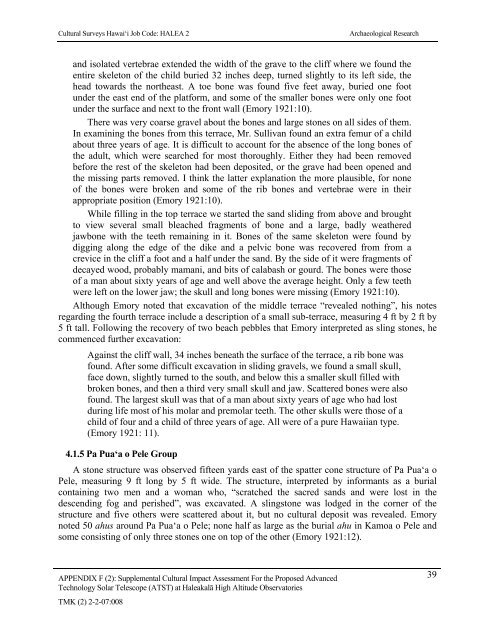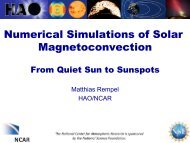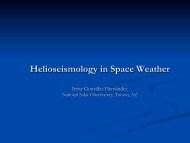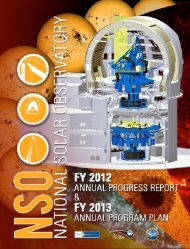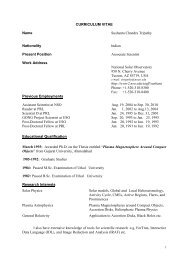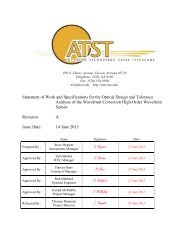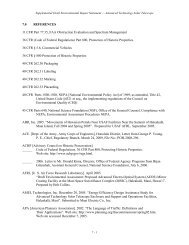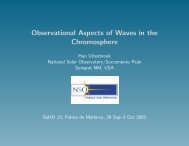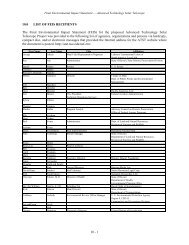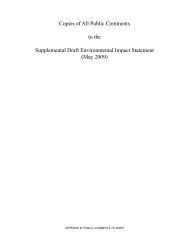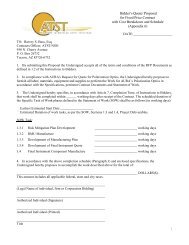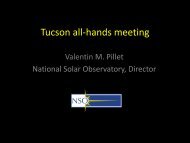F2 - ATST
F2 - ATST
F2 - ATST
You also want an ePaper? Increase the reach of your titles
YUMPU automatically turns print PDFs into web optimized ePapers that Google loves.
Cultural Surveys Hawai‘i Job Code: HALEA 2Archaeological Researchand isolated vertebrae extended the width of the grave to the cliff where we found theentire skeleton of the child buried 32 inches deep, turned slightly to its left side, thehead towards the northeast. A toe bone was found five feet away, buried one footunder the east end of the platform, and some of the smaller bones were only one footunder the surface and next to the front wall (Emory 1921:10).There was very coarse gravel about the bones and large stones on all sides of them.In examining the bones from this terrace, Mr. Sullivan found an extra femur of a childabout three years of age. It is difficult to account for the absence of the long bones ofthe adult, which were searched for most thoroughly. Either they had been removedbefore the rest of the skeleton had been deposited, or the grave had been opened andthe missing parts removed. I think the latter explanation the more plausible, for noneof the bones were broken and some of the rib bones and vertebrae were in theirappropriate position (Emory 1921:10).While filling in the top terrace we started the sand sliding from above and broughtto view several small bleached fragments of bone and a large, badly weatheredjawbone with the teeth remaining in it. Bones of the same skeleton were found bydigging along the edge of the dike and a pelvic bone was recovered from from acrevice in the cliff a foot and a half under the sand. By the side of it were fragments ofdecayed wood, probably mamani, and bits of calabash or gourd. The bones were thoseof a man about sixty years of age and well above the average height. Only a few teethwere left on the lower jaw; the skull and long bones were missing (Emory 1921:10).Although Emory noted that excavation of the middle terrace “revealed nothing”, his notesregarding the fourth terrace include a description of a small sub-terrace, measuring 4 ft by 2 ft by5 ft tall. Following the recovery of two beach pebbles that Emory interpreted as sling stones, hecommenced further excavation:Against the cliff wall, 34 inches beneath the surface of the terrace, a rib bone wasfound. After some difficult excavation in sliding gravels, we found a small skull,face down, slightly turned to the south, and below this a smaller skull filled withbroken bones, and then a third very small skull and jaw. Scattered bones were alsofound. The largest skull was that of a man about sixty years of age who had lostduring life most of his molar and premolar teeth. The other skulls were those of achild of four and a child of three years of age. All were of a pure Hawaiian type.(Emory 1921: 11).4.1.5 Pa Pua‘a o Pele GroupA stone structure was observed fifteen yards east of the spatter cone structure of Pa Pua‘a oPele, measuring 9 ft long by 5 ft wide. The structure, interpreted by informants as a burialcontaining two men and a woman who, “scratched the sacred sands and were lost in thedescending fog and perished”, was excavated. A slingstone was lodged in the corner of thestructure and five others were scattered about it, but no cultural deposit was revealed. Emorynoted 50 ahus around Pa Pua‘a o Pele; none half as large as the burial ahu in Kamoa o Pele andsome consisting of only three stones one on top of the other (Emory 1921:12).APPENDIX F (2): Supplemental Cultural Impact Assessment For the Proposed Advanced 39Technology Solar Telescope (<strong>ATST</strong>) at Haleakalā High Altitude ObservatoriesTMK (2) 2-2-07:008


